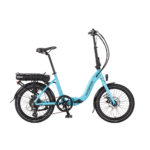I finally got to try out my torq 2 with the 36v ecrazyman controller fitted today,i was really looking forward to trying it as the no load speed was so promising,it is reaching 51mph with the wheel off the ground compared to 24mph with the original controller,on the road it seems to have very little pulling power compared to previously,and sounds rough at low speeds it is only capable of about 14mph on the flat with some assistance compared to about 20mph previously,if the motor is running in this way could the hall or phase wires be wired wrong or both.
Dissapointing first run with ecrazyman controller
- Thread starter fishingpaul
- Start date
Somthing dose sound a bit wired 51mph nls is an advance timing setup.I finally got to try out my torq 2 with the 36v ecrazyman controller fitted today,i was really looking forward to trying it as the no load speed was so promising,it is reaching 51mph with the wheel off the ground compared to 24mph with the original controller,on the road it seems to have very little pulling power compared to previously,and sounds rough at low speeds it is only capable of about 14mph on the flat with some assistance compared to about 20mph previously,if the motor is running in this way could the hall or phase wires be wired wrong or both.
If the torq motor is the same as the Bafang this is one of the three combos that should work.
Motor Controller
Motor Phase -- Controller
B B
G Y
Y G
Hall
Motor Controller
pos pos
neg neg
B B
G Y
Y G
or possable
Bafang PMGR ecrazyman controller
Motor Phase -- Controller
B Y
G G
Y B
Hall
Motor Controller
pos pos
neg neg
B B
G Y
Y G
Phase set to 120 deg (jumpers open)
Thanks for the replys,after trying several combinations i seem to have a smooth start up and it sounds as before im also back to 24mph top speed,i think when the wiring suggested by ecrazyman resulted in a 51mph top speed i thought id struck gold,and although there were doubts in my mind that all was right, my heart was saying yes it must be right and wow it will be so fast.im babysitting tonight so i cannot leave the house to try it out,but it does sound and respond much better than it did so im hopefull now,the combination is now phase wires green to green, yelo to blue,blue to yelo,and hall sensors green to blue,blue to green,yelo to yelo.
The only way to get that high a speed is to increase the voltage, your 51mph seems to be a mistake of some sort. I'll try to explain the physics.
The voltage applied drives the motor forward, as the motor turns it acts as a generator.
The voltage generated opposes the forward (supplied) voltage.
The voltage felt by the motor is the supplied voltage minus the generated voltage, this motor voltage reduces as the motor accelerates.
When the forward voltage equals the back voltage the motor reaches it's no load speed, at this speed the motor produces no power.
The motor has a performance constant that you can use to determine how fast it will spin for a given applied voltage, this is measured in volts/rpm and is solely determined by the motor design.
If your motor was reaching 51mph and it might be possible then the controller must have been increasing the voltage beyond the supply (battery) Voltage. To do this there must have been an element of something called resonance in the way it was been run, its like feedback on a guitar.
This resonance must have been multiplying the voltage but in an inductive/capacitive circuit were resonance is produced there is a phase difference between the voltage and the current.
So you may have had high voltage, which would give a high no load speed, but the current would either lead or lag behind giving little power.
Power output (Pout) = Current (I) x Generated voltage (EMFback)
If your motor has a 24mph no load speed at 36volts then the voltage being generated by the motor should be approaching -36volts at 24mph, at 51mph the motor would be generating about 76volts.
Altering the controller design will only allow higher speeds when it allows the controller to produce more power at higher speeds.
For instance the speed limiter on the mark one Torques allowed higher speed when removed. The controllers use pulse width modulators, appling short power pulses to the motor gives low speed, long pulses for high speed.
The speed limiters do not directly limit current, they limit maximum pulse width, and hence the power particularly at high speed.
I seem to remember you were considering running the motor at 48v. On E-bike.ca they advertise the motor as been a 24 to 48v motor.
If your going to over volt the motor it's not going to be the voltage that damages it but the current, most controllers have a maximum current rating some have limiters as well, it depends what you have.
If my explanations a little ropey I apologise it's a fair time since I learnt it, hopefully some one will be able to expand on it.
The voltage applied drives the motor forward, as the motor turns it acts as a generator.
The voltage generated opposes the forward (supplied) voltage.
The voltage felt by the motor is the supplied voltage minus the generated voltage, this motor voltage reduces as the motor accelerates.
When the forward voltage equals the back voltage the motor reaches it's no load speed, at this speed the motor produces no power.
The motor has a performance constant that you can use to determine how fast it will spin for a given applied voltage, this is measured in volts/rpm and is solely determined by the motor design.
If your motor was reaching 51mph and it might be possible then the controller must have been increasing the voltage beyond the supply (battery) Voltage. To do this there must have been an element of something called resonance in the way it was been run, its like feedback on a guitar.
This resonance must have been multiplying the voltage but in an inductive/capacitive circuit were resonance is produced there is a phase difference between the voltage and the current.
So you may have had high voltage, which would give a high no load speed, but the current would either lead or lag behind giving little power.
Power output (Pout) = Current (I) x Generated voltage (EMFback)
If your motor has a 24mph no load speed at 36volts then the voltage being generated by the motor should be approaching -36volts at 24mph, at 51mph the motor would be generating about 76volts.
Altering the controller design will only allow higher speeds when it allows the controller to produce more power at higher speeds.
For instance the speed limiter on the mark one Torques allowed higher speed when removed. The controllers use pulse width modulators, appling short power pulses to the motor gives low speed, long pulses for high speed.
The speed limiters do not directly limit current, they limit maximum pulse width, and hence the power particularly at high speed.
I seem to remember you were considering running the motor at 48v. On E-bike.ca they advertise the motor as been a 24 to 48v motor.
If your going to over volt the motor it's not going to be the voltage that damages it but the current, most controllers have a maximum current rating some have limiters as well, it depends what you have.
If my explanations a little ropey I apologise it's a fair time since I learnt it, hopefully some one will be able to expand on it.
Related Articles
-
 MTF Enterprises announces acquisition of EMU Electric Bikes
MTF Enterprises announces acquisition of EMU Electric Bikes- Started by: Pedelecs
-
 Wisper 806T folding bike wins Which? ‘Best Buy’
Wisper 806T folding bike wins Which? ‘Best Buy’- Started by: Pedelecs
-
 Sustrans calls for protected cycle lanes
Sustrans calls for protected cycle lanes- Started by: Pedelecs
-
 Amazon launch their first UK e-cargo micromobility hub
Amazon launch their first UK e-cargo micromobility hub- Started by: Pedelecs


